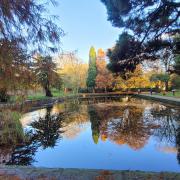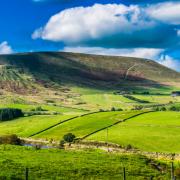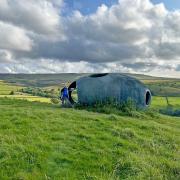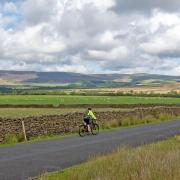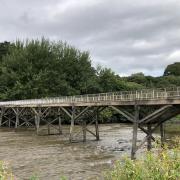John Lenehan toasts the re-opening of a Lancashire engineering landmark and notes an invention to revive any walker.

Last November, after 15 long years, the magnificent Martholme Viaduct was re-opened to walkers. It can only be accessed at the moment from the Great Harwood permissible footpath along the disused railway or by steps from Martholme Lane. The Read end of the viaduct is still closed and it is not possible to carry on along the disused railway. This may change as there are hopes that eventually the line to Padiham will be re-opened. However, this should not deter anyone from visiting the viaduct because the view from the top is fantastic. I decided to design a circular walk that encompassed the viaduct and some lovely and interesting countryside.
The Walk
1. Leave the car park turn left and follow the road to and over the bridge over the River Calder then turn right towards Read Garden Centre. At the garden centre, keep left and follow the track uphill to join the A671 Whalley Road.

2. Cross the road and take the single track road up towards Read Hall (Hammond Drive). The road forks with the right turn going to Read Hall, keep left then keep following Hammond Drive as it goes behind Read Hall and passes through a group of houses. Eventually the road reaches Whins Lane and at this point turn right.
Note: Read Hall was built by the Nowell family, one of whose members Roger Nowell was the magistrate who in 1612 sent the Lancashire Witches to Lancaster Castle for trial and eventual execution.

There was also a battle fought at Read Bridge in 1643 during the English Civil War in which the Parliamentarian army was victorious. With only 400 soldiers they managed to defeat a force of 4,000 Royalists that had taken the nearby village of Whalley.
3. Turn right down George Lane and follow this down to where it joins Whalley Road then turn left.

Note: Read should have a place in the heart of beer drinkers as it was another member of the Nowell family, Alexander, who invented bottled ale. I suggest you honour him by having one once you’ve complated this walk. You can read more about Alexander at the foot of this page.
4. Immediately past the Stuart Frazer Kitchen showroom on the opposite side of the road, turn right and follow the track down to a gate and stile. Cross the stile and keep straight on across a field to another stile. Cross this and bear diagonally left towards a fence and hedgerow the follow this down to a gate and go through this then keeping the fence and hedgerow on the right go downhill to a stile at a cutting in the disused railway embankment. Cross the stile and go through the cutting then bear diagonally right heading downhill towards a metal gate on the riverbank. Just before the gate turn right to a wooden stile and cross this and turn left following a wire fence towards the river and reach a stile on the left. Cross this and follow the riverbank upstream crossing over a stile and a footbridge. Eventually at Altham Bridge climb the stone steps onto the bridge.
Note: Coal mining was the main industry of Altham and East Lancashire from the 1800s to the 1980s. Only the textile industry overshadowed mining in terms of employment and commercial value to the economy. Altham however, has the grim history of one of the major pit disasters that befell the industry. On the 7th November 1883, an underground explosion at Moorfield Colliery killed 68 men and boys.
5. Once on the bridge, turn right and cross the bridge then keep on the pavement following the road and cross a stone bridge marked Syke Side New Bridge. There are some cottages on the right and just past these there is a footpath sign on the right by a metal gate.
6. Go through the gate and follow the track until it bends sharp right. At this point, there is a footpath sign pointing straight on. Go through the metal gate and keep straight on going through another gate and one more into a lane. Turn right and head towards the farm buildings but, as the lane reaches the farm, there is a metal gate on the left with a footpath sign. Go through the gate then carry on with buildings on the right then at the end of the buildings turn right and the path follows the back of the buildings and barn to a stile.
Cross this and almost immediately there is a gate stile on the left. Go through and drop left down old wooden steps to a stream, cross this and follow the path as it climbs diagonally right up to a field. Head diagonally right directly to a huge electricity pylon and keeping just to the left of it. Continue on to a stile in a wall and cross this. Keeping diagonally right, cross the field heading towards the cottages of Brownsills and reach a gate stile by a metal gate. Go through this then turn left and go through another stile and then another by a gate and enter the lane at Brownsills. Follow the lane downhill and over the bridge that crosses a stream then uphill.
7. A sign by a stile on the right says Concessionary Footpath. Go through the stile and you are on the bed of the disused railway. Follow this all the way to Martholme Viaduct.
It is fine to go onto and across the viaduct but the far end is blocked by a steel fence. Having enjoyed the views, turn back and go down the steps on the right to the foot of the viaduct and through a stile into Martholme Lane. Turn left and follow the lane up to the main road.
Note: Martholme viaduct has 10 arches and its highest points stands 65ft (20m) above the River Calder. It was completed in 1877 and was part of the Great Harwood Loop on the East Lancashire Line and had stations at Great Harwood, Simonstone and Padiham. It closed in 1964.
8. Turn right on to the A680 and back to the car park.
Compass points
Start and Finish: The Game Cock Inn car park A680 Great Harwood. The Game Cock welcomes walkers and walking groups. Please ask permission as a matter of courtesy if using the car park and, if a large group is intending to walk from there please contact the Game Cock prior to the walk as there may be a wedding or othe function on the day.
Distance: 6.3 miles/10.15km
Time: 3 hours
Map: OS Map 287 West Pennine Moors
Facilities: The nearest public toilets are in Whalley.
Alexander Nowell
Lancashire has given the world so much but bottled beer must be up there with some of the great inventions.
Alexander Nowell (1517-1602) was the eldest son of John Nowell, of Read Hall, and his mother was Elizabeth Kay of Rochdale. He became an English Protestant theologian and clergyman, serving as Dean of St Paul’s during much of Elizabeth I’s reign.
He was educated at Middleton, near Rochdale, and at Brasenose College, Oxford, but for recreation he took up fly fishing. It was during one of his trips that he found an unopened bottle of ale that had been left in the grass for several days.
He took off the stopper and it made a noise like a gun going off. However, he was surprised to discover the beer inside was in perfect condition. Bottled beer was born.


















